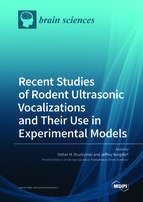Recent Studies of Rodent Ultrasonic Vocalizations and Their Use in Experimental Models
A special issue of Brain Sciences (ISSN 2076-3425). This special issue belongs to the section "Behavioral Neuroscience".
Deadline for manuscript submissions: closed (30 April 2021) | Viewed by 53104
Special Issue Editors
Interests: Ultrassonic vocalization; 22 kHz calls; 50 kHz calls; Emotions; Emotional arousal; Emotional expression; Neuropsychiatric diseases; Emotional dysfunctions; Rats
Interests: Behavioral Neuroscience; Neuropsychopharmacology;Ultrassonic vocalization; 22 kHz calls; 50 kHz calls; Emotions; Emotional arousal; Emotional expression; Neuropsychiatric diseases; Emotional dysfunctions; Rats
Special Issue Information
Dear Colleagues,
Interest in emission of rodent ultrasonic vocalizations and their biological functions has markedly increased in behavioral neuroscience studies of recent years. Particularly, rat vocalizations were used in studies of vocal expression of emotional states and in numerous animal models of neuropsychiatric diseases and disorders. Usefulness of rat vocalization for these studies was caused by the fact that rats emit two acoustically distinct ultrasonic calls that signal two different internal emotional arousals or states: the aversive or negative state or the positive or appetitive state. By recording and measuring emission of these calls, researchers have insight into animal emotional states and their dysfunctions in pathological conditions. Thus, investigations of emission of ultrasonic vocalizations are useful in studies of emotional disturbances, affective disorders, autism, addiction, developmental abnormalities, and many other pathologies. The Special Issue of Brain Sciences entitled “Recent Studies of Rodent Ultrasonic Vocalizations and their use in experimental models” offers a collection of recent developments in this field, and more importantly, many examples how studies of rat ultrasonic vocalization can be, and are, applied in biobehavioral and neuropsychiatric research. This issue is addressed to professionals in the subfields of behavioral neuroscience.
Prof. Stefan M. Brudzynski
Prof. Jeffrey Burgdorf
Guest Editors
Manuscript Submission Information
Manuscripts should be submitted online at www.mdpi.com by registering and logging in to this website. Once you are registered, click here to go to the submission form. Manuscripts can be submitted until the deadline. All submissions that pass pre-check are peer-reviewed. Accepted papers will be published continuously in the journal (as soon as accepted) and will be listed together on the special issue website. Research articles, review articles as well as short communications are invited. For planned papers, a title and short abstract (about 100 words) can be sent to the Editorial Office for announcement on this website.
Submitted manuscripts should not have been published previously, nor be under consideration for publication elsewhere (except conference proceedings papers). All manuscripts are thoroughly refereed through a single-blind peer-review process. A guide for authors and other relevant information for submission of manuscripts is available on the Instructions for Authors page. Brain Sciences is an international peer-reviewed open access monthly journal published by MDPI.
Please visit the Instructions for Authors page before submitting a manuscript. The Article Processing Charge (APC) for publication in this open access journal is 2200 CHF (Swiss Francs). Submitted papers should be well formatted and use good English. Authors may use MDPI's English editing service prior to publication or during author revisions.
Keywords
- ultrasonic vocalizations
- behavioral neuroscience emotional states
- neuropsychiatric diseases
- neuropsychiatric disorders
- emotional disturbances
- affective disorders
- autism, addiction
- developmental abnormalities
- animal models







